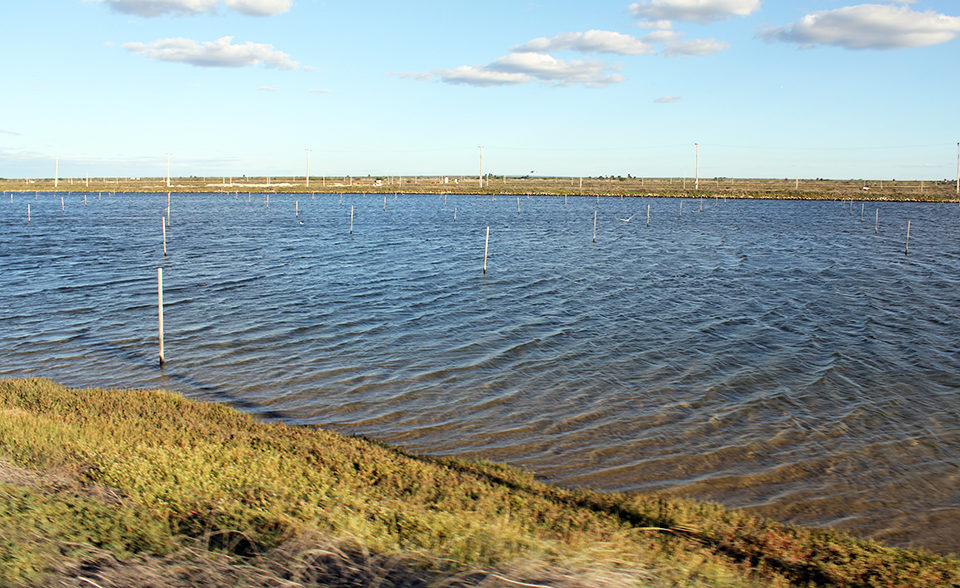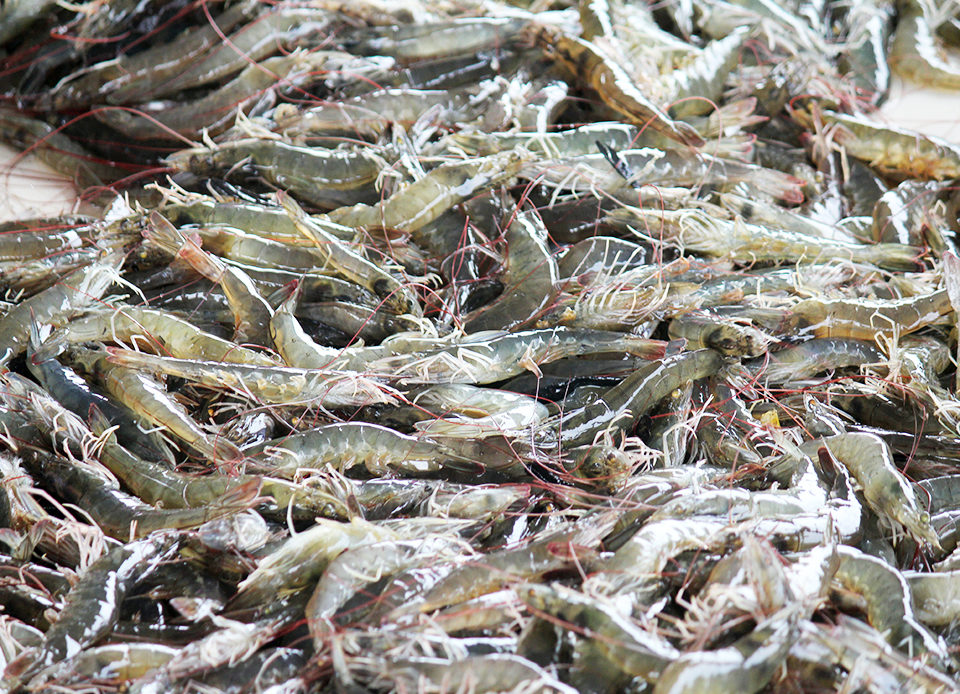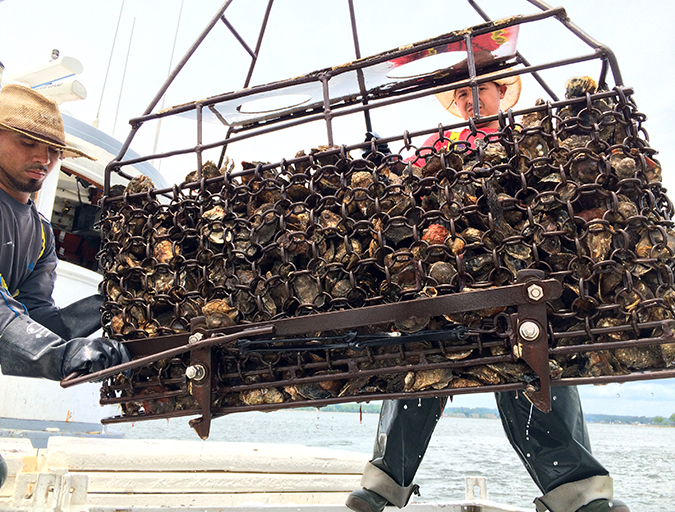Antibiotics do not stop the infection that causes shrimp disease

Vibrio is a genus of Gram-negative bacteria that inhabit most aquatic ecosystems, including freshwater. As of late 2013, there are at least 98 recognized species, with many more candidates. Vibrios serve critical functions in the recycling of nutrients, including polymeric n-acetylglucosamine, a molecule commonly known as chitin, the primary structural component of the exoskeletons of shrimp and other arthropods.
Most vibrios are benign. Many have the ability to degrade chitin by the production of chitinases and readily attach to chitinous invertebrates. They are also often associated with algae and zooplankton, which provide means of transport within aquatic environments and contribute to their ecological stability.
Disease-causing vibrios
Shrimp in the wild, contrasted with those at most farms, live at lower densities and can move when needed to environments of less stress. Stress is frequently an inherent component of the farming process.
A relatively small number of vibrios cause disease in farmed shrimp. Most are opportunistic pathogens that are able to cause disease because the host animals are stressed and impaired in their ability to fight them off. Only a few are obligate pathogens that cause disease in healthy and impaired animals just by being present. The most virulent of these kill shrimp at very low levels of exposure in the water or when consumed.
Since vibrios readily exchange genetic material with each other as well as other bacterial species, they undergo a constant process of evolution. Thus, rapid changes in antibiotic resistance are seen due to the acquisition of genes encoding for these traits. Other phenotypic characteristics can change, as well, including possibly those observed in the etiologic agent(s) of acute hepatopancreatic necrosis (AHPN) or early mortality syndrome in shrimp.
Dr. Donald Lightner and team identified the AHPN pathogen as a unique strain of a relatively common bacterium, Vibrio parahaemolyticus. Lightner determined that the vibrio may have been infected by a virus known as a phage, which could cause it to release a potent toxin.
V. parahaemolyticus is a common inhabitant of most marine, estuarine and some freshwater ecosystems. Most strains are not pathogenic and are harmless to ingest. However, toxin-producing strains of this bacteria, typically found as natural inhabitants in many fish species, are a major cause of seafood poisoning.
Genomic taxonomy
The advent of genomic taxonomy has been instrumental in allowing differentiation among isolates that appear phenotypically and biochemically identical by conventional biochemical testing. Such characterization must occur, or there is significant risk of misidentifying some species. The group of bacteria that are etiologic agent(s) of AHPN are particularly prone to this.
Even very small differences that are consistent can be exploited to develop tools that are critical to the ability to localize a pathogen and come to a more complete understanding of where it is in the environment, from where it comes and how it might be controlled. Until these tools are available, care must be taken in ascribing all cases of AHPN to a single strain of bacteria – although the possibility exists that such a strain might be sufficiently unique to merit becoming a new vibrio species.
Farmers should appreciate that it is very difficult, if not possible, to totally eradicate any group of bacteria. Nor is this necessarily desirable. As most vibrios are benign and serve a useful purpose, eliminating them opens up niches for other species that may not be benign.
Vibrio cholerae
The vibrio bacteria that are etiologic agent(s) of AHPN exhibit characteristics similar to those of Vibrio cholerae, some strains of which cause cholera, a serious life-threatening disease in humans who drink contaminated water and ingest typically more than a million bacteria at one time. Treatment to restore the electrolyte imbalance along with common antibiotics to lessen the chances of complications can easily cure cholera and V. parahaemolyticus food poisoning.
These rather ubiquitous vibrio pathogens act primarily through the guts of their hosts. Like many other vibrio species, they form biofilms. Cholera typically becomes problematic when drinking water and sewage systems are not properly segregated. A parallel in aquaculture is reusing discharge water with limited treatment in production. Currents containing discharged waters can carry vectors far and wide.
In the early 1990s, cholera spread along more than 1,600 km of Peruvian coast in a very short time, and as it followed rivers and streams, much of Latin America was affected. There is evidence that the etiologic agent of AHPN is being spread similarly.
As with V. cholera, V. parahaemolyticus tolerates a wide range of salinities, pH, temperatures and nutrient conditions. Both species of bacteria readily piggyback on many potential vectors. For example, V. cholerae and V. parahaemolyticus are both commonly associated with many species of marine plankton. They readily attach to chitin, the surfaces of algae and other similar substrates.
Vibrio species can also be spread by broodstock and postlarvae. Clearly the etiologic agent of AHPN occupies many niches. This could explain how it seems to move so easily and why eradication and/or control will not be a simple matter.
Biofilms
Biofilms occur everywhere. Probably the biofilm most familiar to humans is why we brush our teeth. They are implicated in a myriad of disease states and are an effective mechanism for bacteria to spread.
A biofilm is an assemblage of organisms that have attached to a surface – such as detritus on shrimp pond bottoms or, in the case of AHPN, the stomachs of shrimp. The biofilm protects the bacteria within from the action of antibiotics and other bacteria that would seek to occupy the niche themselves.
In the formation of biofilm, the bacteria first attach to the chitinous stomach and gastric mill surfaces in the shrimp. The bacteria then form sticky exopolymers that “glue” the bacteria to the surface. As the biofilm subsequently matures and forms microcolonies, exopolysaccharides protect the bacteria against antibiotics, disinfectants, herbal extracts and other treatments while still allowing normal metabolic cell activity. In its final state, the biofilm begins to detach, and its cells disperse in the environment as a new biofilm develops.
AHPN control
Efforts to control AHPN began long before its identity was established. What was probably AHPN was first reported in China four or so years ago and has spread to a number of other countries. In the author’s opinion, this strain of vibrio will likely spread into those environments that allow it to dominate at the expense of the other bacterial species present.
Given the complex nature of the vibrio taxon, a number of things make AHPN a less-than-straightforward problem to address. The pathogen is unusual in shrimp in terms of how it produces disease. Further analogies with cholera are apparent, as it appears as a toxin-based disease process where the bacteria colonize a limited surface, and the toxin does the damage. Most other pathogenic vibrios invade the animal and through various toxins and their cell wall structural component, lipopolysaccharides, overwhelm the ability of the animal to defend itself, with ensuing decline and death.

The strain of V. parahaemolyticus responsible for AHPN does not appear to be invasive in the sense of finding its way into the hemolymph of animals through injuries or other mechanisms. This explains why antibiotics do not stop the AHPN infection. If the antibiotics are not able to come in contact with the pathogen at sufficient levels to impact it, then they will not work.
Since the abuse of antibiotics in shrimp farming has been a point of concern for some years – although there is room for appropriate use of antibiotics – this is one example where any use of antibiotics would be inappropriate. Furthermore, if the pathogen is present in a biofilm in the stomach, this can protect it from the action of many other compounds that could theoretically kill it. This will pose a serious challenge to those trying to develop treatment modalities.
(Editor’s Note: This article was originally published in the November/December 2013 print edition of the Global Aquaculture Advocate.)
Now that you've reached the end of the article ...
… please consider supporting GSA’s mission to advance responsible seafood practices through education, advocacy and third-party assurances. The Advocate aims to document the evolution of responsible seafood practices and share the expansive knowledge of our vast network of contributors.
By becoming a Global Seafood Alliance member, you’re ensuring that all of the pre-competitive work we do through member benefits, resources and events can continue. Individual membership costs just $50 a year.
Not a GSA member? Join us.
Author
-
Stephen G. Newman, Ph.D.
6722 162nd Place Southwest
Lynnwood, Washington 98037-2716 USA
Related Posts

Responsibility
A look at various intensive shrimp farming systems in Asia
The impact of diseases led some Asian shrimp farming countries to develop biofloc and recirculation aquaculture system (RAS) production technologies. Treating incoming water for culture operations and wastewater treatment are biosecurity measures for disease prevention and control.

Intelligence
As ocean temperatures rise, so too will vibrio outbreaks
A study using a half-century of data has linked climate change and warming sea temperatures with an increase in illnesses from the common vibrio bacteria. Shellfish growers, fighting a particularly virulent strain of Vibrio parahaemolyticus, are changing their harvest protocols.

Health & Welfare
A holistic management approach to EMS
Early Mortality Syndrome has devastated farmed shrimp in Asia and Latin America. With better understanding of the pathogen and the development and improvement of novel strategies, shrimp farmers are now able to better manage the disease.

Aquafeeds
A look at protease enzymes in crustacean nutrition
Food digestion involves digestive enzymes to break down polymeric macromolecules and facilitate nutrient absorption. Enzyme supplementation in aquafeeds is a major alternative to improve feed quality and nutrient digestibility, gut health, compensate digestive enzymes when needed, and may also improve immune responses.



